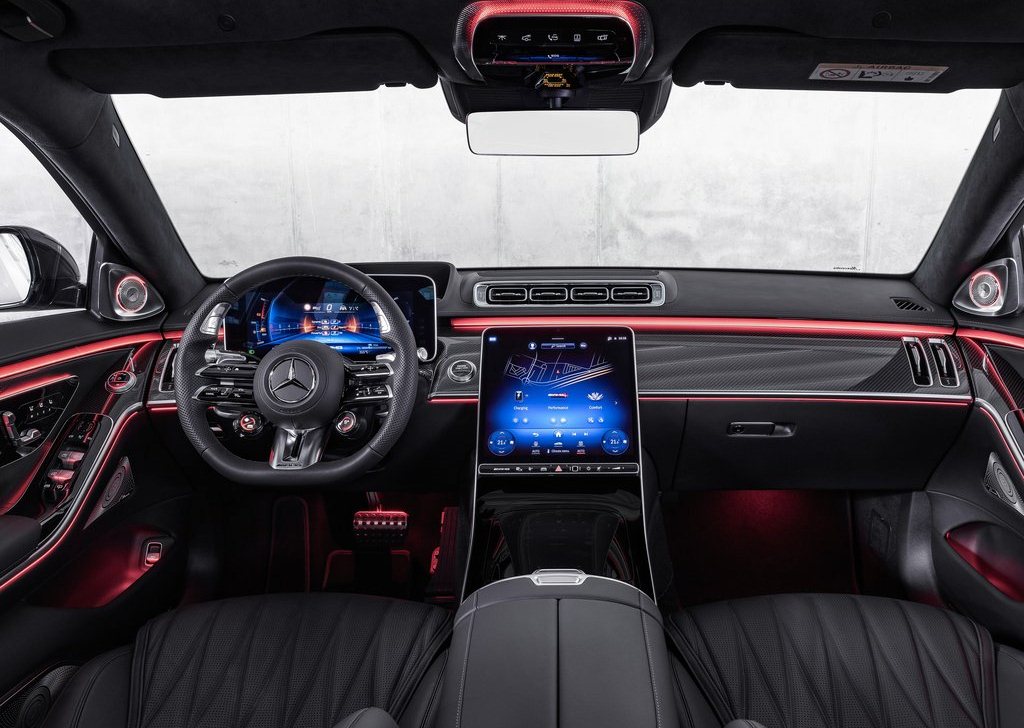The S-Class has always played an important role for Mercedes-AMG. More than 50 years ago, the founders already proved that they could transform a luxury saloon into a very sporty vehicle with the Swabian spirit of innovation. The performance and sports car brand from Affalterbach set its first milestone in 1971, with the Mercedes-Benz 300 SEL 6.8 AMG. Today, the new Mercedes-AMG S63 E PERFORMANCE with AMG hybrid technology once again sets the benchmark in the segment. The E PERFORMANCE model combines the AMG 4.0-litre V8 biturbo engine with the AMG-specific hybrid powertrain and a new expansion stage of the AMG high-performance battery (HPB). The new HPB 150 is based on the high-performance and directly cooled battery cells of the well-known HPB 80. The energy content increases from 6.1 in the HPB 80 to 13.1 kWh in the HPB 150. This increases the all-electric range to 33 kilometres.
The focus of the powertrain, however, is less on electric range and more on best-in-class performance. With 590 kW (802 hp) of system output and 1430 Nm of system torque, the saloon sets new standards in the segment. The acceleration of 3.3 seconds to 100 km/h and the optional top speed of 290 km/h underline the superior, dynamic driving performance. Systems such as the AMG RIDE CONTROL+ suspension, AMG ACTIVE RIDE CONTROL roll stabilisation and rear-axle steering as standard ensure a wide spread between driving dynamics and comfort.
The AMG-specific E PERFORMANCE hybrid drive: combustion engine in the front, electric motor in the rear
In the new Mercedes-AMG S63 E PERFORMANCE, the 4.0-litre V8 biturbo engine is combined with a permanently excited synchronous electric motor, a high-performance battery developed in Affalterbach and the fully variable AMG Performance 4MATIC+ all-wheel drive system. The system output of 590 kW (802 hp) and the maximum system torque of 1430 Nm make for impressive driving performance: Acceleration from standstill to 100 km/h takes just 3.3 seconds. Power delivery only ends at an electronically governed 290 km/h (with the optional AMG Driver's Package).
The 140 kW (190 hp) electric motor is positioned at the rear axle, where it is integrated with an electrically shifted two-speed transmission and the electronically controlled limited-slip rear differential to form a compact electric drive unit (EDU). Experts refer to this layout as a P3 hybrid. The high-performance battery is also located in the rear above the rear axle.
70 kW continuous output and 140 kW peak output
The high-performance battery in the S63 E PERFORMANCE has a capacity of 13.1 kWh, more than twice as much as the already familiar HPB 80. It delivers 70 kW of continuous mechanical power and 140 kW of peak mechanical power (for ten seconds) to the electric motor. External charging takes place via the 3.7 kW onboard AC charger, at a charging station, wallbox or household socket. The battery is designed for fast power delivery and draw, not for the longest possible range. Nevertheless, the electric range of 33 kilometres allows a practical operating radius, for example for quiet all-electric driving from a residential area.
The continual push for innovation: direct cooling of the battery cells
The basis for the high performance of the AMG 400-volt battery is direct cooling: A high-tech coolant based on an electrically non-conductive liquid flows around all 1200 cells and cools them individually. Every battery needs a defined temperature for optimum power delivery. If the energy storage unit gets too cold or too hot, it temporarily loses noticeable power or has to be turned down in order not to be damaged if the temperature level is too high. The consistent temperature of the battery therefore has a decisive influence on its performance, service life and safety. Conventional cooling systems, which use only air or cool the entire battery pack indirectly with water, quickly reach their limits If the thermal management does not fulfil its function optimally, the battery is at risk of ageing prematurely.
For direct cooling, the AMG team had to develop new cooling modules of millimetric thickness. Around 14 litres of coolant circulate from top to bottom through the entire battery, past each cell, with the help of a specially developed high-performance electric pump. In the process, the coolant also flows through an oil/water heat exchanger attached directly to the battery. This conducts the heat into one of the two low-temperature circuits (LT) of the vehicle. From there, it goes on to the LT cooler at the front of the car, which releases the heat into the outside air. The system is designed to ensure even heat distribution in the battery.







![2026 Audi Q5 e-hybrid [UK]](https://blogger.googleusercontent.com/img/b/R29vZ2xl/AVvXsEir1a6nfgXgtK2fLYDmw32_LgM7-BTCu-x6BWuvsz6Zob0dI7Dj87zV25C64wn6qNwehWPOHznrilqaN3bQcuByKu8-5-zzXGYpG3NMggCmTYeHOfVPXOV8SYGLk09Z-S2osgYXrO-wn1uql1-9ixgnTGxF7Q3-bDgKumui6w2oF8FLdREx4YjXAU2hFfOC/w680/2026%20Audi%20Q5%20e-hybrid%20%5BUK%5D_01.jpg)








![2026 Kia Sportage [EU] Review: A Refined European Crossover with Bold Style and Electrified Options](https://blogger.googleusercontent.com/img/b/R29vZ2xl/AVvXsEgqMRwJE1m90uCMgRSB6oc4bAzmAaKXJlNoCwavK5fXHaphLYY1sUVXdxUC94zuj95CdjDG2SqRnUBYMqta-dapTLIaHhzEdJAS821ldVMQOKfAZNpQlZ5fYTwKzKbKj8ad9QeKlaQPcNLRZ6zaGvuXhsg1kQ6zQCQqYtjmOM8q9u-a7Nl3WYjp773OLXJR/w680/2026%20Kia%20Sportage%20%5BEU%5D_01.jpg)





0 Comments